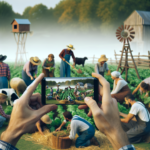Introduction to Video Marketing in Agriculture
Did you know that users view more than 1 billion hours of video each day on YouTube alone? This begs the question: are you leveraging the power of video for your agricultural business? If not, it’s high time to consider how video marketing could help boost your brand.
In this blog post, we’ll be discussing the specifics of video marketing, especially geared towards the agriculture sector. We’re going to cover exactly what video marketing is and its many benefits. We’ll also explore numerous types of video content you can create for your business, the steps to start your video marketing endeavors, and which tools and resources can help you out.
But we’re not stopping there! We also have some best practices to share, examples of video marketing in the agricultural industry, and excellent content ideas. And yes, we haven’t forgotten about those all-important metrics that will help you analyze your video marketing performance.
So, buckle up and join us on an exploration of the world of video marketing for agriculture. Let’s go!
Understanding Video Marketing
What Is Video Marketing?
Video marketing refers to the use of video content to promote products, services, or brands. This strategy involves creating videos that engage, inform, and entertain viewers while delivering a marketing message.
Companies often use video marketing to reach a broad audience quickly. This form of marketing can be used on various platforms, including websites, social media, and email campaigns.
Benefits of Video Marketing
- Increased Engagement: Videos are more likely to capture attention than text or images.
- Higher Conversion Rates: Well-produced videos can lead to higher sales and sign-up rates.
- Improved SEO: Videos can boost search engine rankings when optimized properly.
- Enhanced Understanding: Complex products or services can be explained more effectively.
Types of Video Content
- Tutorials: “How-to” videos that educate viewers on using a product.
- Product Demos: Showcasing the features and benefits of a product.
- Customer Testimonials: Real-life experiences from satisfied customers.
- Live Streams: Real-time video content, often used for events or Q&A sessions.
Steps to Get Started with Video Marketing
- Define Goals: Identify what you want to achieve (e.g., brand awareness, lead generation).
- Create a Budget: Determine the amount of money you can invest in production and promotion.
- Choose Platforms: Decide where your videos will be published (YouTube, Facebook, etc.).
- Plan Content: Brainstorm ideas and develop a content calendar.
Tools and Resources
| Tool | Use | Link |
|---|---|---|
| Adobe Premiere Pro | Video Editing | Adobe Premiere Pro |
| Canva | Video Graphics | Canva |
| Vidyard | Video Hosting | Vidyard |
| Tubebuddy | YouTube SEO | Tubebuddy |
Best Practices for Video Marketing
- Keep it Short: Aim for videos that are 2-3 minutes long.
- Focus on Quality: Ensure good lighting, sound, and editing.
- Include a Call-to-Action: Guide viewers on what to do next (e.g., visit a website).
- Analyze Performance: Use analytics tools to measure the impact of your videos.
For additional insights, you can check out this comprehensive guide from HubSpot.
Video Marketing in Agriculture
How Does Video Marketing Apply to Agriculture?
For agriculture, video marketing has proven to be an effective tool in engaging with customers and potential clients. Given the visual nature of farming and its products, video can bring the agriculture experience to viewers who may otherwise not have access to it. These videos can range from showcasing farm-to-table processes, introducing new agricultural technology, to educating the public about sustainable farming practices.
The Role of Video Content in Agriculture
- Educational Content: Videos can provide clear demonstrations on modern farming techniques and process, offering beneficial knowledge to other farmers or interested parties.
- Farm Tours: Virtual tours of the farm, allowing viewers to experience farming operations, and appreciate the quality and effort involved in the production of their food.
- Sustainability Showcases: Highlighting eco-friendly initiatives and how the farm contributes to sustainability can reel in environmentally conscious consumers.
Benefits of Video Marketing in Agriculture
- Better Consumer Connection: Customers gain an emotional connection by seeing where and how their food is produced, fostering trust in the brand.
- Improved Community Outreach: Sharing of local farming stories can help increase community support and advocacy for local farmers.
- Reduced Misconceptions: Farmers can tackle misconceptions about the industry, such as the use of pesticides, through accessible, easy-to-understand videos.
Creating an Effective Agricultural Video Marketing Strategy
- Tell a Story: Frame your videos around a compelling narrative to hook your viewers’ interests.
- Show Authenticity: Use real images and footage from your farms, don’t opt for stock photos or staged scenes.
- Make It Varied: Diversify your content with different types of videos to keep things fresh and engaging.
- Include a Call-to-Action: Encourage viewers to purchase your product or explore more about your farm or agricultural practice.
Examples of Successful Video Marketing in Agriculture
One successful example of video marketing in agriculture comes from the California almond industry, specifically the Almond Board of California. This organization created a series of videos to showcase the almond farming process and innovative practices like water efficiency[1]. From blossoming orchards to harvest and hulling, these videos offer an insightful and engaging look into the world of almond farming.
Choosing the Right Platform
Identifying where to publish your videos is equally important. Each platform (such as YouTube, Facebook, or your own website) attracts a different audience and offers a unique set of features. Therefore, a combination of platforms is often the best choice, adapting your content as necessary for each platform’s specific audience and norms.
Using Video Marketing for Agricultural Businesses
Content Ideas for Agricultural Video Marketing
Agricultural businesses can leverage video marketing in various ways to enhance their brand visibility and connect with their audience. Here are a few more specific content ideas tailored to agriculture:
- Day-in-the-Life Videos: Take viewers through a typical day on the farm. This can humanize your brand and show the hard work and dedication behind your products.
- Seasonal Updates: Share videos that update your audience on what’s happening each season, such as planting in the spring or harvesting in the fall.
- Recipes and Cooking Tips: Showcase how to use your products in the kitchen with recipe videos and cooking tips, which can add value for your customers.
- Collaborations with Influencers: Partner with influencers in the agricultural or culinary world to create engaging and authentic content that reaches a broader audience.
Tips for Producing High-Quality Agricultural Videos
Creating effective video content requires a few technical and creative considerations specific to the agricultural sector:
- Invest in Good Equipment: Good quality cameras and sound equipment are important. Poor visual or audio quality can distract from your message.
- Use Natural Lighting: Farm settings often provide beautiful natural light; make sure to use this to your advantage for your videos.
- Stabilize Your Shots: Use tripods or gimbals to ensure your footage is steady and professional-looking.
- Capture High-Resolution Drone Footage: Aerial shots can offer spectacular views of your farmland, providing a unique perspective that viewers will find engaging.
- Edit Thoughtfully: Use editing tools to cut unnecessary parts, add value through captions, and enhance visual and audio quality.
Using Analytics to Improve Video Marketing
Knowing how your videos are performing helps you refine your strategy. Here are some key metrics and ways to use them:
- View Count: Indicates the number of times your video has been watched. High view counts can signal engaging content.
- Watch Time: Shows how long viewers are watching your video. Longer watch times often indicate more engaging content.
- Engagement Rate: Measures likes, shares, and comments. Higher engagement can signify a strong connection with your audience.
- Conversion Rate: The percentage of viewers who take a desired action, like buying a product or signing up for a newsletter.
- Playback Location: Helps you understand where viewers are finding your videos, aiding in platform-specific optimizations.
Tools like Google Analytics and platform-specific analytics from YouTube or Facebook can offer these insights. Regularly review this data to adjust your content strategy and improve overall effectiveness.
Legal and Practical Guidelines
When producing video content, it’s important to be mindful of specific legal and practical guidelines:
- Obtain Permits: If you’re filming on locations outside your property, ensure you have the necessary permits.
- Respect Privacy: Avoid capturing footage of individuals without their consent. This includes workers, neighboring properties, and other private areas.
- Be Honest: Ensure your videos accurately represent your products and practices. Misleading content can damage your reputation and lead to legal issues.
- Disclose Sponsorships: If you’re collaborating with influencers or other brands, make sure these relationships are transparently disclosed to maintain trust.
Leveraging Social Media for Distribution
Each social media platform has its nuances, so tailor your video content accordingly:
- YouTube: Ideal for longer-form content, educational series, and detailed farm tours. Optimize with keywords and engaging thumbnails.
- Facebook: Great for engaging with a community through live streams, short updates, and seasonal content.
- Instagram: Use for visually appealing snippets, IGTV for longer videos, and Reels for short, engaging clips.
- Twitter: Aim for quick, impactful videos that highlight key messages, using relevant hashtags to increase visibility.
- LinkedIn: Target B2B relationships by sharing industry insights, process improvements, and sustainability efforts.
Effective video marketing for agricultural businesses involves strategic content creation, appropriate tool usage, analytic tracking, and adhering to guidelines. By embracing these elements, agricultural enterprises can significantly enhance their reach and impact in the digital space. For additional insights, you can check out this comprehensive guide from HubSpot.
Examples of Marketing Channels in Agriculture
Direct-to-Consumer Channels
Agricultural businesses use various avenues to reach consumers directly. These channels allow farmers to sell their products without intermediaries, fostering a closer connection with the consumer.
- Farmers Markets: Local markets where farmers sell directly to consumers, providing fresh produce and fostering community relationships.
- Online Stores: E-commerce platforms where consumers can order produce directly from farms. Websites and dedicated marketplaces like Amazon Fresh and LocalHarvest are popular choices.
- Community-Supported Agriculture (CSA): Subscription-based model where consumers receive regular deliveries of farm produce, often on a weekly basis.
Wholesale and Distribution Channels
Wholesale channels involve selling large quantities of produce to retailers, restaurants, or food service providers. This strategy requires different marketing approaches compared to direct-to-consumer.
- Distributors: Companies that buy produce from farms and sell it to grocery stores, restaurants, and other outlets. Examples include Sysco and US Foods.
- Retail Chains: Large supermarkets and grocery stores like Walmart, Kroger, and Whole Foods that purchase in bulk directly from farmers or through distributors.
- Food Hubs: Regional organizations that aggregate and distribute products from multiple local farms to larger markets.
Institutional Sales Channels
Institutional sales offer a huge market for agricultural products, requiring contracts and long-term commitments.
- Schools: Farm-to-school programs provide fresh produce to school cafeterias, promoting healthy eating among students.
- Hospitals: Healthcare institutions incorporating fresh and local produce into patient meals and cafeteria offerings.
- Corporate Cafeterias: Businesses sourcing healthy, fresh produce for their employee dining facilities.
Export Markets
Exporting agricultural products can expand a farm’s reach beyond local and national boundaries, but it involves understanding and navigating complex regulations.
- International Distributors: Companies and agents who facilitate the export of agricultural products to foreign markets.
- Trade Agreements: Formal agreements between countries that reduce barriers to the import and export of goods, like the USMCA between the U.S., Mexico, and Canada.
- Government Agencies: Organizations like the USDA Foreign Agricultural Service (FAS) that provide support and resources for farmers looking to enter export markets.
Cooperative Marketing
Cooperatives allow farmers to pool resources for marketing, distribution, and sales, providing collective bargaining power and shared costs.
- Marketing Cooperatives: Groups that collectively market and sell members’ products. Examples include dairy co-ops like Organic Valley.
- Supply Cooperatives: Organizations where farmers band together to purchase supplies in bulk, reducing costs (e.g., CHS Inc., an agricultural cooperative based in the USA).
- Processing Cooperatives: Facilities where members’ products are processed, packaged, and marketed collectively.
Subscription Box Services
Subscription services offer curated boxes of farm products delivered periodically, often focusing on seasonal produce.
- Farm Share Programs: Similar to CSA, but may include products from multiple farms curated into one box.
- Online Subscription Services: Companies like Blue Apron or Misfits Market that source products directly from farms and deliver them to subscribers.
- Specialty Boxes: Services offering niche products like organic produce, heirloom varieties, or specialty meats.
Exploring these various marketing channels can significantly broaden an agricultural business’s customer base and revenue streams, adapting to both local markets and the global economy. For more information on leveraging these channels, the Agriculture website provides a wealth of resources and guides.
Conclusion: Key Takeaways for Successful Agricultural Video Marketing
Video marketing stands as a powerful tool for agricultural businesses today, turning complex farming processes into engaging stories. By creating diverse video content from tutorials to live streams, businesses can enhance engagement, inform customers, and even increase conversion rates. However, success in this area entails more than just filming; businesses also need to establish clear goals, invest wisely, and leverage suitable platforms for distribution. Notably, it’s essential to adhere to legal and practical guidelines while respecting privacy and truthfulness.
Furthermore, continuous tracking of performance through analytics helps refine strategies over time. By embracing all aspects of video marketing, agricultural businesses can meaningfully extend their reach and impact in the evolving digital landscape.
Frequently Asked Questions – FAQs
What is video marketing in agriculture?
Video marketing in agriculture uses video content to promote agricultural products, processes, and principles. It can help educate viewers about agricultural practices, showcase individual farms and products, and demonstrate sustainable farming methods.
Why should agricultural businesses leverage video marketing?
Video marketing can significantly enhance an agricultural business’s branding and customer engagement. It can depict complex farming processes in a relatable manner, foster emotional connections with viewers, and even challenge misconceptions about the industry.</






